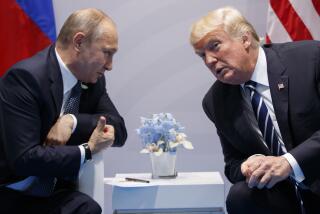America’s Stake in the Awesome Struggle Over Russia’s Future
- Share via
U.S.-Russia relations, whose course has seldom run smooth in this century, may be heading for another rough patch.
If so it will be familiar territory. Russians and Americans have never made war on each other, but more than once they have come uncomfortably close.
After the Bolsheviks seized control of the Russian Revolution in 1917, the United States militarily intervened along with other World War I allies in an effort aimed mainly at keeping Russia from making a separate peace with Germany. Not until 1933 did Washington extend diplomatic recognition to Moscow. But mistrust remained, even during the period of the Grand Alliance that defeated Nazi Germany. The hegemony extended by the Soviet Union over Eastern Europe after that conflict, the Korean War, the Cuban missile crisis in 1962 and the Soviet invasion of Afghanistan in 1979 were among the low points of a cold war whose sudden end was proclaimed just a few years ago. With that proclamation came soaring hopes for a new era of amity and cooperation.
Those hopes have faded. The Russia of today is not the Russia of even a few months ago. Boris N. Yeltsin remains president and Viktor S. Chernomyrdin is still prime minister. But their government seems to have only an uncertain grip on the levers of power and a far-from-sure sense of what its strategy should be in the ongoing struggle to determine Russia’s future.
Russia’s long history of authoritarianism has always cast doubts over its prospects for moving from despotism to democracy, from a command economy to a free economy. Deepening uncertainties about those prospects have prompted a quiet and necessary reappraisal of U.S. policy toward Moscow.
Except for the rare surfacing, such as the bizarre flap in which he initially snubbed the visiting former U.S. President Richard Nixon, Yeltsin, perhaps for health reasons, has withdrawn from much of the daily business of governing. That detachment correlates with the startling showing made in last December’s parliamentary elections by an anti-reform bloc dominated by extremists of the right and left.
Less than two months ago Yeltsin assured President Clinton that he would stay the course on reform. That promise stands suspended. Yeltsin and Chernomyrdin have read the election results, which were widely interpreted as resentment over the unavoidable pains brought by economic change and which measured the success of the neo-fascist demagogue Vladimir V. Zhirinosvky. Their response has been to boot out of government the boldest advocates of free-market reforms, while re-empowering those whose economic ideas have not progressed beyond the stagnant Brezhnev years.
Russia’s foreign policy, meanwhile, shows every sign of being propelled by a rising wave of nationalism and nostalgia for the recent imperial past. Moscow’s decision--with its historical echo of pan-Slavism--to involve itself on behalf of Serbian interests in Bosnia was widely hailed as serving notice on the West that Russia had re-emerged as a major regional player.
The region of most immediate concern to Moscow is the “near abroad,” the states of the former Soviet Union where Yeltsin and others now talk openly about Russia’s “right” to intervene.
The hard policy choices all this presents for the United States are apparent. Russia, as it has since the time of Peter the Great, is again arguing with itself over the direction of its political orientation. There is a realistic chance that out of this fierce debate could come policies and actions that will demolish the dreams that communism’s collapse encouraged. This debate could, alternatively, rage inconclusively for some time. Thus the United States must remain steady and sure about where its own permanent interests lie, and gear its policies accordingly.
One of those interests is to encourage progress toward a free-market economy, however hard a slog that may be. The picture is not wholly bleak. Most U.S. aid to Russia supports privatization and entrepreneurship, and progress in these areas is impressive. More than 75% of Russia’s retail stores and small businesses are now in private hands. More than 25% of the labor force already works in the private sector. Expansion of the market economy should be nourished.
The United States should also continue to enlist Russian cooperation in vital areas, for example, in nuclear non-proliferation. At the same time the Clinton Administration must support the independence and territorial integrity of the former republics of the Soviet Union. That doesn’t mean extending NATO defense guarantees to these states, many of them embroiled in their own internal power struggles. It does mean making clear that Moscow will pay a high political price if it uses force to reassert Russian control in its former empire.
The Bolshevik seizure of power in 1917 inaugurated a tumultuous era in Russian and world history. The struggle over Russia’s future that has ensued in the wake of communism’s collapse could be tumultuous as well.
U.S. policy toward Russia must be rooted in realism, free from romantic illusions as well as from exaggerated fears. Europe’s and America’s interests would of course be best served if democratic reformers triumph. But outside powers can influence that outcome at best only marginally. Ultimately, as in 1917, the forces that will decide and define Russia’s fate lie almost wholly within Russia itself.
More to Read
Sign up for Essential California
The most important California stories and recommendations in your inbox every morning.
You may occasionally receive promotional content from the Los Angeles Times.













